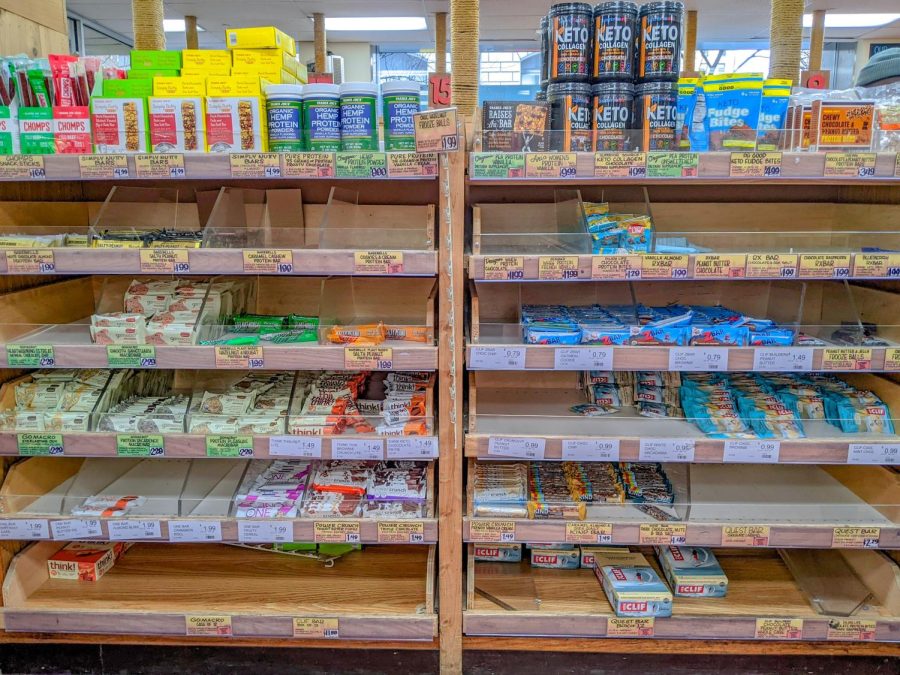Empty shelves at the grocery store? Blame supply chain issues.
The uptick in product prices and lack of shelf stock have led New York City residents to reevaluate their food consumption habits.
While the omicron surge in New York City has died down, COVID-19 continues to impact supply chains and grocery prices. (Photo by Noma Mirny)
February 17, 2022
Many grocery stores in New York City are struggling to keep their shelves stocked due to supply chain holdups and other remaining impacts of the omicron surge. To keep up with demand, supermarkets across the city have increased prices, forcing consumers to change their shopping habits.
The U.S. Department of Labor found that consumer prices have increased by 7.5% since last year — the largest year-on-year increase since the 1981-82 recession. Consumer prices in New York City, when compared to the change in the national average for urban areas across the same time period, are around 10% higher. CAS sophomore Justin Pfister said he recently noticed the cost of products such as milk and bananas increase.
“I need to eat at the end of the day, right? It’s a necessity,” Pfister said. “If the prices are going to be more expensive like for my basic necessities, then I’m just going to spend less money on other things.”
In January, the cost of eggs, dairy and cereal products rose by 0.9% in the span of a single month. Some products, including oranges, are facing shortages not seen since World War II. The price of fresh fruit increased by 13.9% compared to the previous year.
Avocado prices will likely increase after the United States suspended avocado imports from Mexico. The suspension came after a health inspector received death threats for denying an avocado shipment on Feb. 12.
Lindsey Kalish, a first-year at the School of Professional Studies, said she has not been able to regularly buy staple grocery items in the city due to the rise in prices.
“I’ve been asking my parents to bring me groceries from New Jersey because there’s so much more available than in the city,” Kalish said.
The spike in prices is attributed in part to employee shortages in essential supply chain industries. The trucking industry, which transports around 72.5% of all freight in the United States, employs around 6% of the nation’s full-time workers. In 2021, there was a shortage of 80,000 truck drivers — nearly 20,000 higher than in 2018 — due to COVID-19 and high retirement rates.
“It was absolutely fine for me for years, but since the past few months, grocery shopping has been getting worse and worse, to the point that I don’t know where to go to buy the things that I actually love,” CAS French language professor Anna-Caroline Prost said of the price increases.
COVID-19 infections among workers across the supply chain have also led to many calling in sick and some quitting. A survey by the National Grocers Association revealed that many retail and grocery stores were operating with roughly half of their standard workforce.
Fatoumata Kamara, a cashier at Gristedes on University Place, said store regulars have been angry at the price increases. Kamara said that manufactures are continuing to increase prices of chips, snacks and most dairy products.
“I had a co-worker show me a paper where they increased a lot of the things like the milk that used to be $1.59 is now $1.79,” Kamara said. “And they want to know why. And every time [the co-worker] answers, ‘Something’s wrong with the manufacturers.’”
To avoid higher prices and fewer product choices, some city residents have begun shopping online. Grocery delivery services such as Instacart are dominating the national market, with the industry expected to grow by 25% over the next three years. Other consumers have shopped at large-chain grocery stores to avoid the higher prices of local stores.
“It ends up being much cheaper to go to supermarkets outside my neighborhood than the local grocery store,” CAS senior Laura Mazoni said. “This price increase has changed my way of consuming food because now I spend more time getting groceries than before.”
Andrea Leon and Gabriel Hawthorne contributed reporting.
Contact Abby Wilson at [email protected] and Lauren Ashe at [email protected].


























































































































































